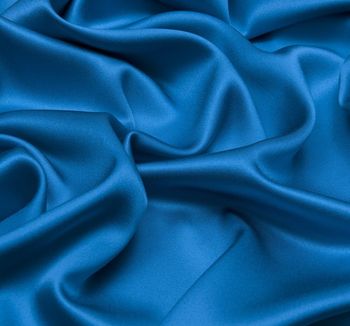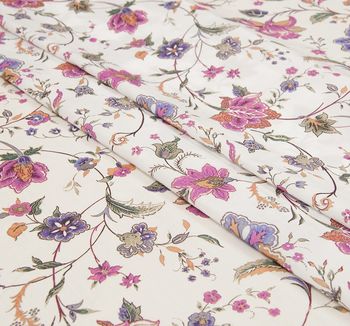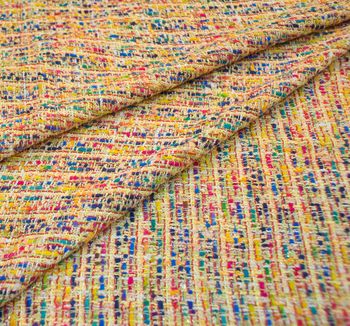Silk is a timelessly trendy natural fabric woven from the cocoons of silk worms. The world’s most famous fashion brands regularly apply it for various men’s and women’s outfits earning the admiration of the audience.
Bridal Fabrics Ultimate Guide
The wedding dress is one of the most important clothing items a woman gets to choose in her lifetime. It can be made of silk or cotton, lace or tulle, be strewn with sequins or embroidered with beads.
There are dozens of silhouettes suitable for different body shapes: A-line, fit-and-flare, form-fitting, column, and so on. The traditional colors such as white, ivory and ecru are still high on the roll, but more and more brides choose colored wedding dress fabrics.
You can buy a bridal dress in a boutique or have your own sewn just for you. When a gown is custom-made, it’s almost a guarantee that it’s going to be the right shape, the right color and the right design. There are so many types of wedding dress fabrics, but they all differ in texture, feel and drape. We are going to focus on the differences between various kinds of bridal fabrics, which ones are better for which season and what every bride should take into consideration when designing her dream dress.
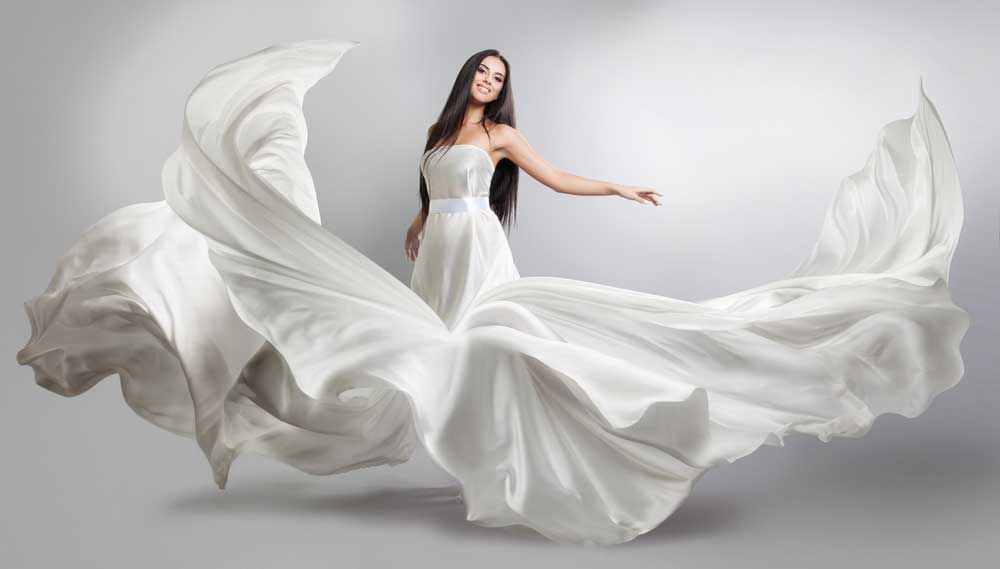
What Are the Best Wedding Dress Fabrics by Season?
It is easy to get lost in this variety of fabrics usually found in bridal gowns. Unless one is a qualified seamstress or sewist, an expert advice is needed to make up the mind and choose the right wedding dress material.
Some fabrics are comfortable to wear in summer, whereas others are best suited for fall and winter. Plus, there is a whole range of wedding materials that can be worn all year round. Silk is a very popular choice in bridal wear, since it comes in various textures and weights and has this oh-so-elegant feel about it. Cotton also pops up in brides’ fashion lists, especially when a wedding is planned for summer. Keep in mind though that the same style will look different in different fabrics.
Below is the list of lightweight textiles advisable for spring and summer.
|
Fabric |
Properties |
Best for |
|---|---|---|
|
Chiffon |
A sheer material with a slightly bumpy texture. Almost weightless, it is just the right thing for warmer weather. |
Draped, layered and flowing designs, empire styles |
|
Organza |
A sheer fabric, usually made of silk. It is stiffer than chiffon, yet is very delicate. It adds more body to the underneath. Great option for sunny days. |
Structured designs, ball gowns, veils |
|
Charmeuse |
A sleek and soft fabric with a glossy sheen like that of satin. Quite clingy, it looks best on a flawless body. |
Column designs, form-fitting dresses |
|
Crepe |
A lightweight fabric with a crepe-like, grainy feel. Ideal for hotter days. |
Draped styles, soft silhouettes |
|
Batiste |
A semi-sheer fabric with a soft hand, usually made of cotton. Perfectly breathable, it is often used for vintage dresses. |
Overlays, veils |
|
Voile |
A plain weave fabric with a slightly crisp hand, usually made of cotton. A perfectly breathable, semi-sheer material for summer weddings. |
Relaxed fit, draped designs, casual style |
What about autumn/winter? As the temperature falls, one needs heavier wedding fabrics to stay cozy and comfortable.
|
Fabric |
Properties |
Best for |
|---|---|---|
|
Satin |
A very smooth and lustrous fabric, usually made of silk. Satin comes in various weights and degrees of transparency, but most satin fabrics are opaque and moderately thick. A great choice for cool weather. Duchesse satin is one of the best picks for winter weddings. |
Structured gowns, bodycon shapes, draped or ruched designs |
|
Brocade |
An opaque fabric with a raised pattern. One of the best fabrics for head-spinning, elegant designs. Brocade is quite heavy and is best used in fall or winter. |
A-line styles, structured dresses |
|
Velvet |
An opaque fabric with a soft pile that can be made of silk, cotton, viscose, etc. Quite warm and regal-looking, it is ideal for colder weather. Crushed velvet and stretch velvet are also worth a look. |
A-line styles, bodycon designs, column dresses |
There are some fabrics that are a pleasure to wear all year round, be it early spring, the height of summer or Christmas Eve.
|
Fabric |
Properties |
Best for |
|---|---|---|
|
Tulle |
A net-like fabric, very lightweight and sheer. A popular choice for wedding veils, gloves, overlays or skirts. It adds more body to the underneath. Tulle looks its best when combined with lace or satin. |
Full shapes, ballerina styles, overlays and underlays |
|
Lace |
An open weave fabric produced in a wide range of styles. The sheerest one is perfect for spring and summer (Chantilly), while heavier types are best suited for cooler weather (guipure or wool lace). Great for decorating bodices, sleeves, necklines, hems, it is often combined with other fabrics. |
All types of silhouettes, overlays and details |
|
Shantung |
A medium weight fabric with a slightly coarse hand and a unique texture. It holds its shape well and has a great drape. |
Draped designs |
|
Taffeta |
A smooth and shiny fabric with a signature rustle, usually made of silk. Lighter quality is good for summer, while heavier taffeta is perfect for fall and winter. A wonderful choice for a bridal dress would be shot taffeta with an iridescent sheen, also known as changeant. |
All types of dresses, draped designs, full skirts |
Embroidered Wedding Dresses
There are so many different wedding dress styles to choose from. You could go with a plain one in a solid color, or opt for a fancier gown embroidered with silky threads, beads or sequins.
Embroidered wedding gowns come in all sorts of silhouettes:
- Empire dress with a high waistline and a long skirt.
- A-line dress with a fitted bust and a full skirt.
- Sheath dress with a body-hugging cut.
- Fishtail or mermaid dress with a fitted top and a flaring bottom.
- Ball gown with a full, gathered or pleated skirt.
- Column dress with a close-fitting, straight cut.
What sets them apart is exquisite embroidered fabrics, which can be decoreated either all-over or partial. From simple lines to highly detailed patterns, it brings a unique touch of personality to a wedding dress. The most gorgeous – and time-consuming – is hand embroidery. One can use matt or lurex threads, or decorate the bridal outfit with a scattering of Swarovski crystals, as well as embellished patches. Embroidered lace fabric is a sure fire way to steal the show.
4 Tips for Choosing the Right Fabric for a Bridal Gown
A beautiful fabric is key when it comes to bridal wear. Before saying yes to the dress, there are some things one needs to consider not to be disappointed with the result. In fact, it all starts with a bride’s body shape that dictates what kinds of fabrics work best for her. Here are some points to think about when selecting the wedding dress material:
Tip #1: Style & Cut
Bridal fashion never sleeps. Each season brings new silhouettes and designs, some of which become classic, while others have to go. A-line or fishtail, fitted or full, sweetheart or strapless, structured or flowy… Weigh up the pros and cons based on your body shape.
Tip #2: Season
Now that you’ve chosen the style, think about the season. The type of fabric best suited for a wedding dress depends a lot on the weather conditions. Go with lightweight materials for warmer months and leave heavier fabrics for cold weather. Velvet is luxurious, but is it worth wearing it on a hot July day?
Tip #3: Texture & Drape
Smooth and rough, see-through and opaque, shiny and matt – the world of fabrics has it all. What kind of drape would you like? Consider all these factors before making a decision. E.g., brocade is perfect for glamorous wedding gowns, while Chantilly lace fabric reveals itself best in diaphanous looks.
Tip #4: Color & Pattern
Last but not least, select the color. Solid or bright? Floral patterns or some strict geometry? Some of the most popular colors you can expect to see in bridal wear include stark white, ecru, champagne, cream, and ivory.
In general, bridal gowns are made of several fabrics. There is a common practice to use stronger materials for bodices and underskirts, and softer cloths for other parts.
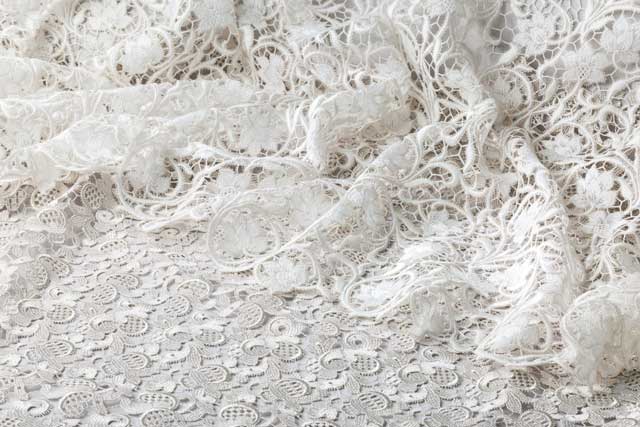
What Are the Most Popular Wedding Gown Colors?
The answer is white, by all means. It stands for purity and innocence, and works for most skin types. However, bridal fashion has come up with a number of unconventional options for colored wedding dresses, including pastel tints and bold accents to vivify the traditional gown.
Here are some colors one can choose to walk down the aisle.
- White
- Ivory
- Champagne
- Blush or pale pink
- Light blue
- Lavender
- Red
- Black
White and off-white are a number one choice in modern bridal fashion. Pastel tints are perfect for romantic brides seeking to add a hint of color while keeping their look classic. Red and black are ideal for ladies with flamboyant personality. Bright colors represent power and energy, and never fail to make a statement.
There are a lot of ways to incorporate bold hues into a contemporary bride’s wardrobe, especially if it’s a themed or destination wedding.
- Trim sleeves or hem with contrast ribbons.
- Make a colorful sash.
- Add a pop of color with a contrast petticoat.
- Go for a vibrant wrap, bolero, jacket, gloves or even veil.
- Put on bold-colored shoes.
- Decorate your dress with colored embroidery or appliques.
Bridal Fashion 2018
A wedding dress is both an intimate and personal for a woman — it must reflect the personality and style of the bride.
Carolina Herrera
Every year the bridal fashion market comes up with a bunch of fresh ideas to celebrate the big day. Many girls still prefer classics, but there are some brides who are willing to go a new path.
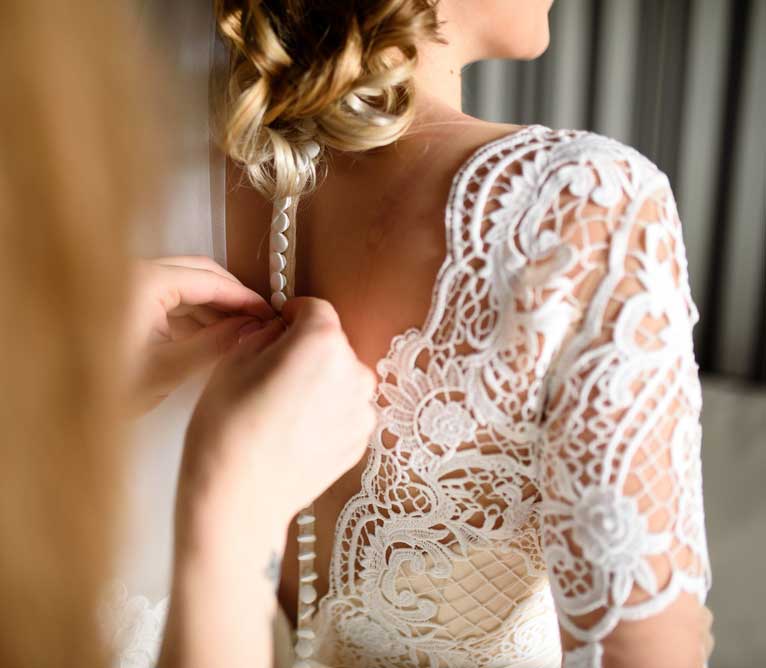
White lace fabric is one of the most feminine materials when it comes to bridal wear, with satin silk fabrics snapping at its heels. Offered in a great number of styles, these wedding dress fabrics speak luxury and set a refined mood for any wedding. How to create a high-fashion look in 2018? Here are some clues from the bridal runways:
- Deep V-necklines
- High neck
- Off-the-shoulder
- Plenty of ostrich feathers
- Bridal capes, capelets and boleros
- 3D floral embellishments
- Oversize bows
Fabric designers have created thousands of exquisite fabrics, from finest silks to heavy embroideries, and this year’s selection of textiles is both charming and inspiring. Luxury brands offer stunning haute couture designs that are a treat to the eyes – think gauziest voile strewn with a myriad of pearls, delicate organza with sparkling crystals, satin stich embroidery on a whole range of backgrounds, or sheerest tulle decorated with floral motifs. When imagination meets innovation, anything is possible. The 2018 bride is presented with an infinite number of stunning fabric options, perfect for a second-to-none wedding dress.
While white still rules the bridal world, there are two more colors that have proved to be popular with fashion designers – rose pink and celestial blue, which are Pantone’s colors of the year.
A bridal gown is the most important item on a bride’s list. However, there are a couple of other things that contribute to her look: a pair of gloves, a veil, a bolero – you name it. Do not forget to include these details into your wedding project and compare various fabric textures to come up with the most beautiful combination.
Tissura Bridal Fabric Collection
Tissura offers a large regular collection of bridal fabrics from Europe's most reputable brands, such as Sophie Hallette, Riechers Marescot, Solstiss, HOH, Frontline, Luigi Verga, Ruffo Coli, Taroni, Marco Lagatolla and others. Some of the most luxurious lace designs are represented in the table below. To get more information about each one, just click on the photo, and you will be redirected on the product page. To see the whole collection of bridal lace at Tissura, click on the button "Buy Bridal Fabrics Here" below the table:
Guipure lace fabric, 238 € (295 US$) per one running metre;
Silk crepe back satin, 81 € (101 US$) per one running metre;
Embroidered tulle lace fabric, 241 € (298 US$) per one running metre;
Double faced jacquard cloque, 199 € (246 US$) per one running metre
How to stay cool on a hot summer day? Wear fabrics built for the heat. Cotton, linen, viscose, silk – there are dozens of summer-friendly materials you can choose for your wardrobe. The best fabric to opt for when the temperature rises should be breathable and comfortable.
Tweed is a medium to heavy weight fabric most often found in jackets, coats and suits. Originally made to fight cold winters, it has become a fabric of choice for many a designer.
.jpg)
.jpg)
.jpg)
.jpg)
